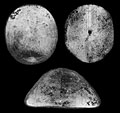Aziz & Badve (2001) state that Progongrochanus can be differentiated from Gongrochanus by "...incipient development of hair like projection in between teeth and depressed peristome" pointing out that such hair like projection grows conspicuously in similar sized Gongrochanus. The terms 'teeth' and 'hair-like projection' are clearly erroneous, probably due to an error in translation. The type species of Gongrochanus, G. herschelianus (McClelland, 1840), has a distinct ridge present in the median area of each phyllode, between the bourrelets. This is likely to be the "...hair like projection in between the teeth" referred to by Aziz & Badve (2001). However, their phyllode drawing would appear to indicate the presence of such a ridge, but does not resemble the phyllodes of the specimen of the type species figured. Unfortunately Aziz & Badve (2001) fail to describe the apical system reporting only that it is small with four genitals, not stating whether they mean four genital pores or genital plates. This specimen closely resembles Procassidulus, particularly in phyllode structure, both in the number of pores and in lacking a ridge between the bourrelets. If Progongrochanus posses a tetrabasal apical system with four gonopores, and the phyllode structure of the type species is as shown on their figured specimen, then Progongrochanus should be considered a junior subjective synonym of Procassidulus. However, if the apical system is not tetrabasal with four gonopores, and the phyllode structure is as in Gongrochanus as shown in their Fig. 2, then Progongrochanus should either be considered a subgenus of Gongrochanus or a valid genus. If the validity of this genus is demonstrated, then Gongrochanus clericii (Checchia-Rispoli, 1933) from the Maastrichtian of Libya, which also lacks this ridge in the median area of each phyllode, should potentially be moved into Progongrochanus.
S. A. Aziz & R. M. Badve. 2001. New echinoid fauna from the South Indian Cretaceous deposits. Gond. Geol. Magz., V. 16 (2), pp. 43-59
P. M. Kier. 1962. Revision of the cassiduloid echinoids. Smithsonian Miscellaneous Collections, 144 (3) 262 pp.

